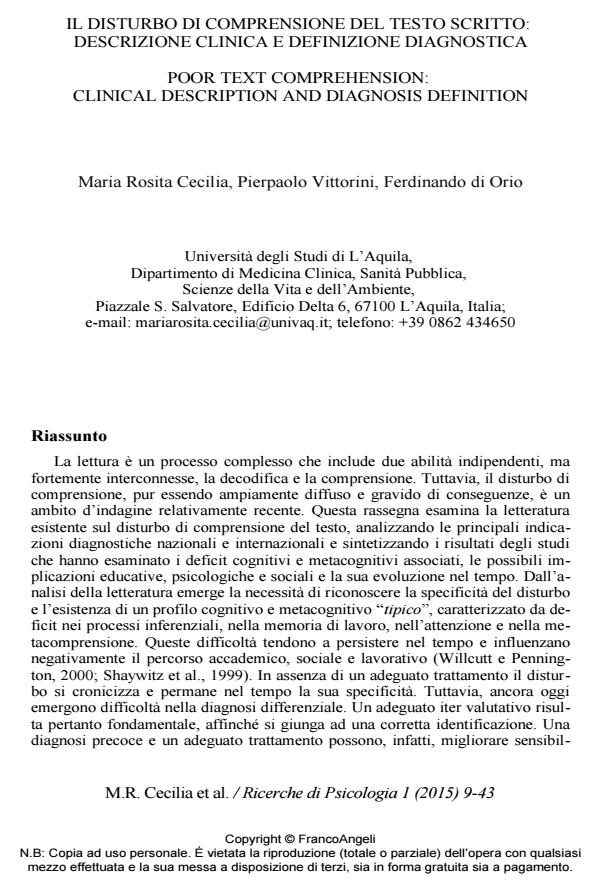Il disturbo di comprensione del testo scritto: descrizione clinica e definizione diagnostica
Titolo Rivista RICERCHE DI PSICOLOGIA
Autori/Curatori Maria Rosita Cecilia, Pierpaolo Vittorini, Ferdinando di Orio
Anno di pubblicazione 2015 Fascicolo 2015/1
Lingua Italiano Numero pagine 35 P. 9-43 Dimensione file 322 KB
DOI 10.3280/RIP2015-001001
Il DOI è il codice a barre della proprietà intellettuale: per saperne di più
clicca qui
Qui sotto puoi vedere in anteprima la prima pagina di questo articolo.
Se questo articolo ti interessa, lo puoi acquistare (e scaricare in formato pdf) seguendo le facili indicazioni per acquistare il download credit. Acquista Download Credits per scaricare questo Articolo in formato PDF

FrancoAngeli è membro della Publishers International Linking Association, Inc (PILA)associazione indipendente e non profit per facilitare (attraverso i servizi tecnologici implementati da CrossRef.org) l’accesso degli studiosi ai contenuti digitali nelle pubblicazioni professionali e scientifiche
La lettura e un processo complesso che include due abilita indipendenti, ma fortemente interconnesse, la decodifica e la comprensione. Tuttavia, il disturbo di comprensione, pur essendo ampiamente diffuso e gravido di conseguenze, e un ambito d’indagine relativamente recente. Questa rassegna esamina la letteratura esistente sul disturbo di comprensione del testo, analizzando le principali indicazioni diagnostiche nazionali e internazionali e sintetizzando i risultati degli studi che hanno esaminato i deficit cognitivi e metacognitivi associati, le possibili implicazioni educative, psicologiche e sociali e la sua evoluzione nel tempo. Dall’analisi della letteratura emerge la necessita di riconoscere la specificita del disturbo e l’esistenza di un profilo cognitivo e metacognitivo "tipico", caratterizzato da deficit nei processi inferenziali, nella memoria di lavoro, nell’attenzione e nella metacomprensione. Queste difficolta tendono a persistere nel tempo e influenzano negativamente il percorso accademico, sociale e lavorativo (Willcutt e Pennington, 2000; Shaywitz et al., 1999). In assenza di un adeguato trattamento il disturbo si cronicizza e permane nel tempo la sua specificita. Tuttavia, ancora oggi emergono difficolta nella diagnosi differenziale. Un adeguato iter valutativo risulta pertanto fondamentale, affinche si giunga ad una corretta identificazione. Una diagnosi precoce e un adeguato trattamento possono, infatti, migliorare sensibilmente la prognosi (Torgerson e Elbourne, 2002), riducendo il rischio di cronicizzazione, con conseguenze positive non solo sul bambino e sulla sua famiglia, ma anche sulla comunita, attraverso un contenimento dei costi destinati all’assistenza (Carretti et al., 2002). Parole chiave: cattivi lettori, disturbi specifici dell’apprendimento, comprensione del testo scritto.
Parole chiave:Poor comprehenders, specific learning disorders, reading comprehension.
- School Refusal in Students with Low Academic Performances and Specific Learning Disorder. The Role of Self-Esteem and Perceived Parental Psychological Control Pina Filippello, Caterina Buzzai, Giovanna Messina, Antonina Viviana Mafodda, Luana Sorrenti, in International Journal of Disability, Development and Education /2020 pp.592
DOI: 10.1080/1034912X.2019.1626006
Maria Rosita Cecilia, Pierpaolo Vittorini, Ferdinando di Orio, Il disturbo di comprensione del testo scritto: descrizione clinica e definizione diagnostica in "RICERCHE DI PSICOLOGIA " 1/2015, pp 9-43, DOI: 10.3280/RIP2015-001001